Claude Monet

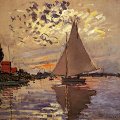 Claude Monet, French painter, is generally
considered to be the most outstanding figure among Impressionists. The
term Impressionism derives from his picture Impression:
Sunrise. Monet was using the short brush strokes, which often
looked rather like spots of paint, not lines. For this reason his
paintings seemed to some people messy and unfinished. Often, when you
looked at his painting from a short distance you couldn't see what it
was, but if you stepped away you could see a beautiful scene. This was
a completely new way of painting that became the mark of Impressionism. Monet was enormously prolific and many major
galleries have examples of his work. Through his life Monet painted
about 2500 paintings. For many years Monet's and other
Impressionists' paintings were not understood and rejected by people
of that time. But finally by the end of century the new way of
painting became liked and popular. Impressionism enriched art, and
taught people to be open and ready to welcome and enjoy the new
styles. Claude Monet, as the leader of Impressionists, made this
success possible in the big part. Without Claude Monet art would
probably never become so interesting, and full of light, and beauty.
Claude Monet, French painter, is generally
considered to be the most outstanding figure among Impressionists. The
term Impressionism derives from his picture Impression:
Sunrise. Monet was using the short brush strokes, which often
looked rather like spots of paint, not lines. For this reason his
paintings seemed to some people messy and unfinished. Often, when you
looked at his painting from a short distance you couldn't see what it
was, but if you stepped away you could see a beautiful scene. This was
a completely new way of painting that became the mark of Impressionism. Monet was enormously prolific and many major
galleries have examples of his work. Through his life Monet painted
about 2500 paintings. For many years Monet's and other
Impressionists' paintings were not understood and rejected by people
of that time. But finally by the end of century the new way of
painting became liked and popular. Impressionism enriched art, and
taught people to be open and ready to welcome and enjoy the new
styles. Claude Monet, as the leader of Impressionists, made this
success possible in the big part. Without Claude Monet art would
probably never become so interesting, and full of light, and beauty.
Claude Monet's most important >
> Best! Paintings
- A Cart on the Snowy Road at Honfleur (1865)
- Le Pave De Chailly (1865)
- Luncheon on the Grass, Central Panel (1865)
- The Pointe De La Heve at Low Tide (1865)
- The Walkers (1865)
- Camille (The Woman with a Green Dress) (1866)
- Jeanne-Marguerite Lecadre in the Garden (1866)
- Women in the Garden (1866)
- Garden at Sainte-Adresse (1867)
- Quai Du Louvre (1867)
- The Beach at Sainte-Adresse (1867)
- Ice Floes on the Seine at Bougival (1868)
- An Interior After Diner (1869)
- Flowers and Fruit (1869)
- La Grenouillere (1869)
- Rough Sea at Etretat (1869)
- The Magpie (1869)
- Entrance to the Port of Trouville (1870)
- The Beach at Trouville 2 (1870)
- The Seine at Bougival in the Evening (1870)
- Train in the Countryside (1870)
- Meditation, Mrs. Monet Sitting on a Sofa (1871)
- The Thames Below Westminster (1871)
- Lilacs, Grey Weather (1872)
- Regatta at Argenteuil (1872)
- The Port at Argenteuil (1872)
- The Promenade at Argenteuil (1872)
- The Railway Station at Argenteuil (1872)
- The Red Kerchief, Portrait of Mrs. Monet (1873)
- The Railway Bridge at Argenteuil (1874)
- The Coal-Dockers (1875)
- The Walk, Woman with a Parasol (1875)
- Turkeys (1876)
- Exterior of Saint-Lazare Station (The Signal) (1877)
- Chrysanthemums (1878)
- The Rue Montorgueil, 30th of June 1878 (1878)
- Breakup of Ice, Grey Weather (1880)
- Breakup of Ice (1880)
- Sunset on the Seine, Winter Effect (1880)
- Low Tide at Pourville (1882)
- Walk on the Cliff at Pourville (1882)
- Beach at Etretat (1883)
- A Field of Tulips in Holland (1886)
- Rocks at Port-Coton, The Lion (1886)
- The Cote Sauvage (1886)
- In the Norvegienne (1887)
- Poplars at Giverny (1888)
- Antibes, Afternoon Effect (1888)
- The Creuse at Sunset (1889)
- Haystacks, White Frost Effect (1891)
- Houses of Parliament, Effect of Sunlight in the Fog (1901)
- Houses of Parlilament, Fog Effect (1903)
- Water Lilies (1919)
- Water-Lilies and Weeping Willow Branches (1919)
A Cart on the Snowy Road at Honfleur (1865)
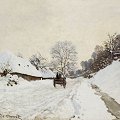 Get
Get  a high-quality picture of
A Cart on the Snowy Road at Honfleur for your computer or notebook. ‣
For over six months, firstly with Bazille and then alone, Monet made the most of the charms of the Normandy coastline, producing a huge range of paintings from nature. He stayed in Honfleur, rising at dawn to seek out fresh subjects which he painted until evening. The Saint Simeon farm, represented on the left of the picture, is located on the road between Honfleur and Trouville. For several generations many painters (including Daubigny, Corot and Courbet) had spent time there, and so it became a recurring theme. In this case however, Monet is primarily interested in snow and its effects: 'We noticed a foot-warmer, then an easel, and then a gentleman, wrapped tightly in three jackets, wearing gloves and a half-frozen expression: it was Monsieur Monet, studying the effects of snow.' (Journal du Havre).
a high-quality picture of
A Cart on the Snowy Road at Honfleur for your computer or notebook. ‣
For over six months, firstly with Bazille and then alone, Monet made the most of the charms of the Normandy coastline, producing a huge range of paintings from nature. He stayed in Honfleur, rising at dawn to seek out fresh subjects which he painted until evening. The Saint Simeon farm, represented on the left of the picture, is located on the road between Honfleur and Trouville. For several generations many painters (including Daubigny, Corot and Courbet) had spent time there, and so it became a recurring theme. In this case however, Monet is primarily interested in snow and its effects: 'We noticed a foot-warmer, then an easel, and then a gentleman, wrapped tightly in three jackets, wearing gloves and a half-frozen expression: it was Monsieur Monet, studying the effects of snow.' (Journal du Havre).
Le Pave De Chailly (1865)
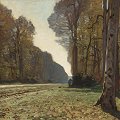 Get
Get  a high-quality picture of
Le Pave De Chailly for your computer or notebook. ‣
In 1863 Monet left Gleyre's studio with his friend Bazille and embarked on a pilgrimage to the favourite location of previous landscape artists of the Barbizon school - the Forest of Fontainebleau. There, he was able to rediscover the whole range of familiar themes that had been celebrated for several decades, including the Pave de Chailly, a vast avenue of almost architectural proportions which acted as a gateway to the forest. He thus had the opportunity to work harder than ever at painting en plein air. According to his friend, Monet was at that point 'pretty good at landscapes', thanks to a well-established practice of painting from nature which he began in his native Normandy under his first master, Boudin. This painting, which still shows the influences of the Barbizon landscape artists and the realism of Courbet, was accepted by the Salon in 1866.
a high-quality picture of
Le Pave De Chailly for your computer or notebook. ‣
In 1863 Monet left Gleyre's studio with his friend Bazille and embarked on a pilgrimage to the favourite location of previous landscape artists of the Barbizon school - the Forest of Fontainebleau. There, he was able to rediscover the whole range of familiar themes that had been celebrated for several decades, including the Pave de Chailly, a vast avenue of almost architectural proportions which acted as a gateway to the forest. He thus had the opportunity to work harder than ever at painting en plein air. According to his friend, Monet was at that point 'pretty good at landscapes', thanks to a well-established practice of painting from nature which he began in his native Normandy under his first master, Boudin. This painting, which still shows the influences of the Barbizon landscape artists and the realism of Courbet, was accepted by the Salon in 1866.
Luncheon on the Grass, Central Panel (1865)
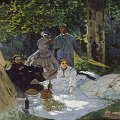 Get
Get  a high-quality picture of
Luncheon on the Grass, Central Panel for your computer or notebook. ‣
In the end the Dejeuner sur l'Herbe project proved too ambitious for Monet. The painting of spectacular proportions would never be completed, nor presented to the Salon as the artist had originally envisaged. He was encouraged, however, by all the young guard of contemporary painters, and he also received Courbet's sound advice. Furthermore, he paid tribute to Courbet by representing him in the picture: he is the figure on the left in this fragment. The painting, pawned in Fontainebleau, would be reclaimed by the artist in 1884 in poor condition. Monet cut it into pieces, and hence the right section of the picture has disappeared. In this fragment, the central part of the original work, the tall male figure standing is recognizable as Bazille, but we do not know the identity of the female figures.
a high-quality picture of
Luncheon on the Grass, Central Panel for your computer or notebook. ‣
In the end the Dejeuner sur l'Herbe project proved too ambitious for Monet. The painting of spectacular proportions would never be completed, nor presented to the Salon as the artist had originally envisaged. He was encouraged, however, by all the young guard of contemporary painters, and he also received Courbet's sound advice. Furthermore, he paid tribute to Courbet by representing him in the picture: he is the figure on the left in this fragment. The painting, pawned in Fontainebleau, would be reclaimed by the artist in 1884 in poor condition. Monet cut it into pieces, and hence the right section of the picture has disappeared. In this fragment, the central part of the original work, the tall male figure standing is recognizable as Bazille, but we do not know the identity of the female figures.
The Pointe De La Heve at Low Tide (1865)
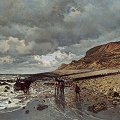 Get
Get  a high-quality picture of
The Pointe De La Heve at Low Tide for your computer or notebook. ‣
In mid-October 1864, Monet spent a few days with his family in
Sainte-Adresse to appease them following their displeasure at his long
absence. He then executed some studies painted near Cap de la Heve, once
again demonstrating his taste for the coastal landscapes of Normandy. But a
heated scene erupted: asked to leave and not to come back in a hurry, Monet
was faced with the threat of having his allowance cut off. The incident
left him into a very difficult position, considering the debts he had
incurred during his stay in Honfleur. Yet he was still obsessed with his
aim of exhibiting in the 1865 Salon. So he worked on repeating his best
studies, with variations, including this view of Sainte-Adresse. At the
Salon, Monet was to assert his independence by refusing to seek a reference
from any of the masters.
a high-quality picture of
The Pointe De La Heve at Low Tide for your computer or notebook. ‣
In mid-October 1864, Monet spent a few days with his family in
Sainte-Adresse to appease them following their displeasure at his long
absence. He then executed some studies painted near Cap de la Heve, once
again demonstrating his taste for the coastal landscapes of Normandy. But a
heated scene erupted: asked to leave and not to come back in a hurry, Monet
was faced with the threat of having his allowance cut off. The incident
left him into a very difficult position, considering the debts he had
incurred during his stay in Honfleur. Yet he was still obsessed with his
aim of exhibiting in the 1865 Salon. So he worked on repeating his best
studies, with variations, including this view of Sainte-Adresse. At the
Salon, Monet was to assert his independence by refusing to seek a reference
from any of the masters.
The Walkers (1865)
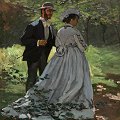 Get
Get  a high-quality picture of
The Walkers for your computer or notebook. ‣
'Like everyone else at that time, I started working with studies from nature and painted the complete work in my studio.' This is Monet's description of the way in which he carried out the Dejeuner sur l'Herbe project. He could not begin his manifesto work en plein air due to the considerable size he had in mind for it. Les Promeneurs is the only one of these preliminary studies painted from nature in Chailly during the summer of 1865 that has been preserved. Monet planned to use it for the left section of the final picture. He turned to his friends and family for models, although rain seriously disrupted the work: Bazille posed for the figure on the left at the end of August, and the female figure was apparently Camille, Monet's future wife.
a high-quality picture of
The Walkers for your computer or notebook. ‣
'Like everyone else at that time, I started working with studies from nature and painted the complete work in my studio.' This is Monet's description of the way in which he carried out the Dejeuner sur l'Herbe project. He could not begin his manifesto work en plein air due to the considerable size he had in mind for it. Les Promeneurs is the only one of these preliminary studies painted from nature in Chailly during the summer of 1865 that has been preserved. Monet planned to use it for the left section of the final picture. He turned to his friends and family for models, although rain seriously disrupted the work: Bazille posed for the figure on the left at the end of August, and the female figure was apparently Camille, Monet's future wife.
Camille (The Woman with a Green Dress) (1866)
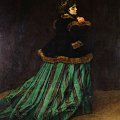 Get
Get  a high-quality picture of
Camille (The Woman with a Green Dress) for your computer or notebook. ‣
Monet's family disapproved of his relationship with Camille Doncieux, and she was never accepted by his parents. From 1866 until her death in 1879, however, she was there at his side and on his canvases. This first portrait was completed in four days leading up to 20 March 1866, the deadline for submission to the Salon, where it replaced the unfinished Dejeuner sur l'Herbe. The dark, neutral background provided Monet with a quick and easy solution that nevertheless gave him the chance to prove his talent for figure painting. The masterly treatment of the silk dress would give the work its title, The Woman in the Green Dress. It was a 'huge success' when it was presented at the Salon, prompting Zola to say of Monet: 'Here is a strong character, a man among all these eunuchs.'
a high-quality picture of
Camille (The Woman with a Green Dress) for your computer or notebook. ‣
Monet's family disapproved of his relationship with Camille Doncieux, and she was never accepted by his parents. From 1866 until her death in 1879, however, she was there at his side and on his canvases. This first portrait was completed in four days leading up to 20 March 1866, the deadline for submission to the Salon, where it replaced the unfinished Dejeuner sur l'Herbe. The dark, neutral background provided Monet with a quick and easy solution that nevertheless gave him the chance to prove his talent for figure painting. The masterly treatment of the silk dress would give the work its title, The Woman in the Green Dress. It was a 'huge success' when it was presented at the Salon, prompting Zola to say of Monet: 'Here is a strong character, a man among all these eunuchs.'
Jeanne-Marguerite Lecadre in the Garden (1866)
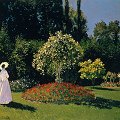 Get
Get  a high-quality picture of
Jeanne-Marguerite Lecadre in the Garden for your computer or notebook. ‣
This portrait of one of the painter's cousins, Jeanne-Marguerite Lecadre, is an example of the motif of a woman with a parasol; it was executed in the garden of his Aunt Lecadre's house at Sainte-Adresse. Monet's aunt, and main source of support, was delighted at her nephew's initial successes, as he had now sold his first canvases and obtained his first commission. The painter paid her a visit in the summer, giving him the chance to complete this canvas which illustrates the progress of his research into the relation of the figure to a landscape, the decorative exuberance of flowers and foliage, and how to preserve the radiance of a sun-drenched view. To achieve this, Monet gradually introduced a new approach: he abandoned large areas of solid colour in the manner of Courbet, evident in Le Dejeuner sur l'Herbe, in order to move towards a progressively fragmented style.
a high-quality picture of
Jeanne-Marguerite Lecadre in the Garden for your computer or notebook. ‣
This portrait of one of the painter's cousins, Jeanne-Marguerite Lecadre, is an example of the motif of a woman with a parasol; it was executed in the garden of his Aunt Lecadre's house at Sainte-Adresse. Monet's aunt, and main source of support, was delighted at her nephew's initial successes, as he had now sold his first canvases and obtained his first commission. The painter paid her a visit in the summer, giving him the chance to complete this canvas which illustrates the progress of his research into the relation of the figure to a landscape, the decorative exuberance of flowers and foliage, and how to preserve the radiance of a sun-drenched view. To achieve this, Monet gradually introduced a new approach: he abandoned large areas of solid colour in the manner of Courbet, evident in Le Dejeuner sur l'Herbe, in order to move towards a progressively fragmented style.
Women in the Garden (1866)
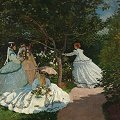 Get
Get  a high-quality picture of
Women in the Garden for your computer or notebook. ‣
Boosted financially by his successes at the 1866 Salon, Monet moved to Sevres and attempted to take his revenge for the failure of Le Dejeuner sur l'Herbe. He needed to complete a large format work en plein air in order to break with the traditional creative process once and for all. To this end, he devised a trench and pulley system that allowed him to hoist the canvas, despite its considerable size, to the desired height for painting. While this painting marked a return for Monet to the image of bourgeois women in Le Dejeuner sur l'Herbe, notably with Camille among the figures on the left, in this case they are alone in their garden. His style was evolving, as he gradually abandoned large areas of solid colour in favour of using small touches to give detail to the painting. Rejected by the Salon, this work was displayed in a shop and then purchased by Bazille for a high price, thus providing his friend with a steady income.
a high-quality picture of
Women in the Garden for your computer or notebook. ‣
Boosted financially by his successes at the 1866 Salon, Monet moved to Sevres and attempted to take his revenge for the failure of Le Dejeuner sur l'Herbe. He needed to complete a large format work en plein air in order to break with the traditional creative process once and for all. To this end, he devised a trench and pulley system that allowed him to hoist the canvas, despite its considerable size, to the desired height for painting. While this painting marked a return for Monet to the image of bourgeois women in Le Dejeuner sur l'Herbe, notably with Camille among the figures on the left, in this case they are alone in their garden. His style was evolving, as he gradually abandoned large areas of solid colour in favour of using small touches to give detail to the painting. Rejected by the Salon, this work was displayed in a shop and then purchased by Bazille for a high price, thus providing his friend with a steady income.
Garden at Sainte-Adresse (1867)
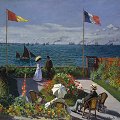 Get
Get  a high-quality picture of
Garden at Sainte-Adresse for your computer or notebook. ‣
When Camille was pregnant with Jean, Monet, who was penniless, left her in Paris and returned to Le Havre to stay with his aunt. He then immersed himself frantically in his work. His relations with his family (especially his father) at that time seem to have improved perceptibly. The way Monet represents his father on this terrace suggests that the two men were on good terms: he is seated in the foreground beside the woman who would finance the early years of the painter's career to a large extent, his aunt, Marie-Jeanne Lecadre. They are both looking at two other people, Monet's cousin Jeanne-Marguerite Lecadre and a man whose identity remains unknown. The flowers spreading out from this terrace combine with the sea, boats and sky, heralding the major works of Impressionism.
a high-quality picture of
Garden at Sainte-Adresse for your computer or notebook. ‣
When Camille was pregnant with Jean, Monet, who was penniless, left her in Paris and returned to Le Havre to stay with his aunt. He then immersed himself frantically in his work. His relations with his family (especially his father) at that time seem to have improved perceptibly. The way Monet represents his father on this terrace suggests that the two men were on good terms: he is seated in the foreground beside the woman who would finance the early years of the painter's career to a large extent, his aunt, Marie-Jeanne Lecadre. They are both looking at two other people, Monet's cousin Jeanne-Marguerite Lecadre and a man whose identity remains unknown. The flowers spreading out from this terrace combine with the sea, boats and sky, heralding the major works of Impressionism.
Quai Du Louvre (1867)
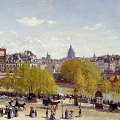 Get
Get  a high-quality picture of
Quai Du Louvre for your computer or notebook. ‣
On 27 April 1867 Monet approached the Louvre superintendant for permission to execute some views from the rooms in the museum. Once this was granted a few days later, he was able to begin three bird's eye views looking towards the church of Saint-Germain-l'Auxerrois and the Seine. These dense, busy canvases reveal the painter's particular liking for vividly portraying the play of light and shadow. The meticulous architectural representation was a way of conveying urban life, a theme that soon became part of the Impressionist world. The schematic silhouettes of figures, horses and cars seem to move or stand still at the dictate of the painter's brush.
a high-quality picture of
Quai Du Louvre for your computer or notebook. ‣
On 27 April 1867 Monet approached the Louvre superintendant for permission to execute some views from the rooms in the museum. Once this was granted a few days later, he was able to begin three bird's eye views looking towards the church of Saint-Germain-l'Auxerrois and the Seine. These dense, busy canvases reveal the painter's particular liking for vividly portraying the play of light and shadow. The meticulous architectural representation was a way of conveying urban life, a theme that soon became part of the Impressionist world. The schematic silhouettes of figures, horses and cars seem to move or stand still at the dictate of the painter's brush.
The Beach at Sainte-Adresse (1867)
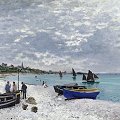 Get
Get  a high-quality picture of
The Beach at Sainte-Adresse for your computer or notebook. ‣
Throughout his childhood and adolescence in the town of Le Havre, the young Monet spent many hours on the shore at Sainte-Adresse. This spot would later become the subject of his earliest works and of several series of canvases. More often than not, he depicted the beach towards the east, and the village church is visible on the left: this marked a break with the works of his master, Eugene Boudin, famous for his views facing the sea. In this Normandy series from 1867, comprising over twenty paintings, Monet's brushstrokes are increasingly fragmented at certain points, signifying an important development compared to the works completed in Fontainebleau Forest two years earlier.
a high-quality picture of
The Beach at Sainte-Adresse for your computer or notebook. ‣
Throughout his childhood and adolescence in the town of Le Havre, the young Monet spent many hours on the shore at Sainte-Adresse. This spot would later become the subject of his earliest works and of several series of canvases. More often than not, he depicted the beach towards the east, and the village church is visible on the left: this marked a break with the works of his master, Eugene Boudin, famous for his views facing the sea. In this Normandy series from 1867, comprising over twenty paintings, Monet's brushstrokes are increasingly fragmented at certain points, signifying an important development compared to the works completed in Fontainebleau Forest two years earlier.
Ice Floes on the Seine at Bougival (1868)
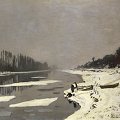 Get
Get  a high-quality picture of
Ice Floes on the Seine at Bougival for your computer or notebook. ‣
After Jean was born, Monet travelled to Paris on several occasions to visit Camille and his son. As winter approached, he moved back there for a short time. When the really cold weather set in, he went to Bougival, which had been transformed by the railway into a place where the Parisian middle classes went on trips, and would become one of the essential locations for Impressionist painters. In that winter of 1867 he painted what became a recurring subject for him: ice floes on the Seine. The river is depicted here flowing towards Rueil, with Ile de Croissy on the left. With this winter landscape, Monet rediscovered the joy he felt in conveying his impressions of snow. What is most striking here, however, is the way the landscape is depicted in blocks of solid colour.
a high-quality picture of
Ice Floes on the Seine at Bougival for your computer or notebook. ‣
After Jean was born, Monet travelled to Paris on several occasions to visit Camille and his son. As winter approached, he moved back there for a short time. When the really cold weather set in, he went to Bougival, which had been transformed by the railway into a place where the Parisian middle classes went on trips, and would become one of the essential locations for Impressionist painters. In that winter of 1867 he painted what became a recurring subject for him: ice floes on the Seine. The river is depicted here flowing towards Rueil, with Ile de Croissy on the left. With this winter landscape, Monet rediscovered the joy he felt in conveying his impressions of snow. What is most striking here, however, is the way the landscape is depicted in blocks of solid colour.
An Interior After Diner (1869)
 Get
Get  a high-quality picture of
An Interior After Diner for your computer or notebook. ‣
During the winter of 1868-1869, the family was finally reunited as Camille and Jean joined Monet. Freed from financial problems, Claude took advantage of this peace of mind to depict Camille, one of her friends, and a neighbour in their house in Etretat. The painting's subtitle (The Sisley family) has for a long time led us to believe that the painter's friend - whom he met in Gleyre's studio and who was present during their stays in Fontainebleau and Normandy - was also in Etretat at this time. Unfortunately the wonderfully calm period in Etretat was short-lived: because she was unhappy about her nephew's relationship, which was now common knowledge in Normandy, his aunt Lecadre refused to pay him the pension that had got him out of trouble.
a high-quality picture of
An Interior After Diner for your computer or notebook. ‣
During the winter of 1868-1869, the family was finally reunited as Camille and Jean joined Monet. Freed from financial problems, Claude took advantage of this peace of mind to depict Camille, one of her friends, and a neighbour in their house in Etretat. The painting's subtitle (The Sisley family) has for a long time led us to believe that the painter's friend - whom he met in Gleyre's studio and who was present during their stays in Fontainebleau and Normandy - was also in Etretat at this time. Unfortunately the wonderfully calm period in Etretat was short-lived: because she was unhappy about her nephew's relationship, which was now common knowledge in Normandy, his aunt Lecadre refused to pay him the pension that had got him out of trouble.
Flowers and Fruit (1869)
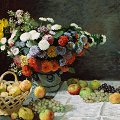 Get
Get  a high-quality picture of
Flowers and Fruit for your computer or notebook. ‣
When bad weather precluded painting en plein air, Monet executed still lifes, especially bouquets of flowers. During the summer and autumn of 1869, he did several of them, including Fleurs et fruits while he was painting with Renoir, who depicted a similar bouquet in one of his pictures (Fleurs dans un vase). Renoir, who lived with his parents very near to Bougival, often came to paint with Monet on the banks of the Seine or in his studio. He also helped Claude by bringing some food when he once again experienced financial difficulties. During this period Monet even found himself forced to deposit a number of his canvases with Pissarro in Louveciennes, for fear of possible seizure.
a high-quality picture of
Flowers and Fruit for your computer or notebook. ‣
When bad weather precluded painting en plein air, Monet executed still lifes, especially bouquets of flowers. During the summer and autumn of 1869, he did several of them, including Fleurs et fruits while he was painting with Renoir, who depicted a similar bouquet in one of his pictures (Fleurs dans un vase). Renoir, who lived with his parents very near to Bougival, often came to paint with Monet on the banks of the Seine or in his studio. He also helped Claude by bringing some food when he once again experienced financial difficulties. During this period Monet even found himself forced to deposit a number of his canvases with Pissarro in Louveciennes, for fear of possible seizure.
La Grenouillere (1869)
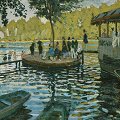 Get
Get  a high-quality picture of
La Grenouillere for your computer or notebook. ‣
When Monet returned to the Paris region, he settled in Bougival, a place frequented by rowers and artists. He met up with Renoir there, and began to work collaboratively with him. The two painters devoted themselves to depicting a place called La Grenouillere, a floating inn by the banks of the Pot o Fleurs islet on the Seine. It was also known as 'the Camembert', and was overlooked by a small tree and connected to the embankments by footbridges. Monet's style gained a hitherto unseen shimmering effect at that point, a stage on the journey to Impressionism. Central to the painting was the study of reflections, broken into wavelets caused by the bathers' movements. A canvas on the same theme was rejected by the Salon in 1870, resulting in the resignations of Daubigny and Corot, who supported the master of 'the school of nature for nature's sake'.
a high-quality picture of
La Grenouillere for your computer or notebook. ‣
When Monet returned to the Paris region, he settled in Bougival, a place frequented by rowers and artists. He met up with Renoir there, and began to work collaboratively with him. The two painters devoted themselves to depicting a place called La Grenouillere, a floating inn by the banks of the Pot o Fleurs islet on the Seine. It was also known as 'the Camembert', and was overlooked by a small tree and connected to the embankments by footbridges. Monet's style gained a hitherto unseen shimmering effect at that point, a stage on the journey to Impressionism. Central to the painting was the study of reflections, broken into wavelets caused by the bathers' movements. A canvas on the same theme was rejected by the Salon in 1870, resulting in the resignations of Daubigny and Corot, who supported the master of 'the school of nature for nature's sake'.
Rough Sea at Etretat (1869)
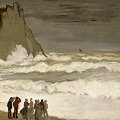 Get
Get  a high-quality picture of
Rough Sea at Etretat for your computer or notebook. ‣
During his stay with his family in Normandy in 1868, Monet was free for a time from financial worries thanks to Monsieur Gaudibert's commissions. Thus he could be reunited with his wife and son, whom he had left in Paris for lack of money; he found accommodation for them on the route du Havre in Etretat. In this town he discovered the subject matter that had previously been celebrated by Delacroix, notably the Porte d'Aval, which can be seen in the background of this landscape. The following winter, the artist painted en plein air the numerous features of the shores around Etretat: pebble beaches, or cliffs with their arches hewn out of the rock. This led to Monet focusing his studies on the waves breaking on the shore. It is more than a mere landscape: the inclusion of silhouettes of people looking into the distance on the beach turns the picture into an account of daily life.
a high-quality picture of
Rough Sea at Etretat for your computer or notebook. ‣
During his stay with his family in Normandy in 1868, Monet was free for a time from financial worries thanks to Monsieur Gaudibert's commissions. Thus he could be reunited with his wife and son, whom he had left in Paris for lack of money; he found accommodation for them on the route du Havre in Etretat. In this town he discovered the subject matter that had previously been celebrated by Delacroix, notably the Porte d'Aval, which can be seen in the background of this landscape. The following winter, the artist painted en plein air the numerous features of the shores around Etretat: pebble beaches, or cliffs with their arches hewn out of the rock. This led to Monet focusing his studies on the waves breaking on the shore. It is more than a mere landscape: the inclusion of silhouettes of people looking into the distance on the beach turns the picture into an account of daily life.
The Magpie (1869)
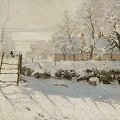 Get
Get  a high-quality picture of
The Magpie for your computer or notebook. ‣
For Monet, painting in the open air was 'even more pleasant, perhaps, in winter than in summer'. For then he could stick to what in his view was a key theme: the effects of snow. In fact with this picture he looked back to the Honfleur snowscapes executed two years previously. This canvas, intended for the 1869 Salon, was rejected. Monet was probably paying the price of being the titular head of the 'new painting' group - painters whom Gerime called a 'bunch of lunatics'. Their success at the exhibition in Latouche's shop (in which Monet took part) caused sensation. The artist then reviewed his projects, and sought to move closer to the capital. In doing so he would be able to paint in a convenient location, and at the same time keep an eye on what was happening in Paris.
a high-quality picture of
The Magpie for your computer or notebook. ‣
For Monet, painting in the open air was 'even more pleasant, perhaps, in winter than in summer'. For then he could stick to what in his view was a key theme: the effects of snow. In fact with this picture he looked back to the Honfleur snowscapes executed two years previously. This canvas, intended for the 1869 Salon, was rejected. Monet was probably paying the price of being the titular head of the 'new painting' group - painters whom Gerime called a 'bunch of lunatics'. Their success at the exhibition in Latouche's shop (in which Monet took part) caused sensation. The artist then reviewed his projects, and sought to move closer to the capital. In doing so he would be able to paint in a convenient location, and at the same time keep an eye on what was happening in Paris.
Entrance to the Port of Trouville (1870)
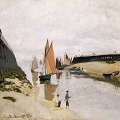 Get
Get  a high-quality picture of
Entrance to the Port of Trouville for your computer or notebook. ‣
Shortly after his marriage, Monet left Bougival with his wife and son Jean to go back once again to the Normandy coast. At this point in early summer, Trouville was a key location in which to represent high society. This painting is the only one from the period that does not depict the pervasive frivolous pursuits. Carrying on the tradition of the previous year's views of Honfleur, Monet focuses here on the vibrant activity of boats and fishermen on the sea rather than on elegant figures on the beach. Thus he represents the mouth of the river Touques which separates Trouville on the right bank from Deauville. Yet again he proved his talent as a painter of marine subjects, earning him his first glowing reviews at the Salon.
a high-quality picture of
Entrance to the Port of Trouville for your computer or notebook. ‣
Shortly after his marriage, Monet left Bougival with his wife and son Jean to go back once again to the Normandy coast. At this point in early summer, Trouville was a key location in which to represent high society. This painting is the only one from the period that does not depict the pervasive frivolous pursuits. Carrying on the tradition of the previous year's views of Honfleur, Monet focuses here on the vibrant activity of boats and fishermen on the sea rather than on elegant figures on the beach. Thus he represents the mouth of the river Touques which separates Trouville on the right bank from Deauville. Yet again he proved his talent as a painter of marine subjects, earning him his first glowing reviews at the Salon.
The Beach at Trouville 2 (1870)
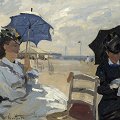 Get
Get  a high-quality picture of
The Beach at Trouville 2 for your computer or notebook. ‣
Once he had set up on the beach at Trouville - the Mecca of high society in summer - Claude Monet was able to depict in full the frivolous nature of the world around him by creating a number of views of it. By executing views of the whole beach he could concentrate on the place where fashionable people paraded up and down. Occasionally the artist also did far more detailed views, often centred on female figures in close-up, which produced more original perspectives. For this painting, however, Monet positioned himself at right angles to the beach and laid out his canvas by juxtaposing the different spaces: the sea, the beach, the wooden walkway and stairs accessing the terrace, and finally the seafront's grand facades lined up in a row.
a high-quality picture of
The Beach at Trouville 2 for your computer or notebook. ‣
Once he had set up on the beach at Trouville - the Mecca of high society in summer - Claude Monet was able to depict in full the frivolous nature of the world around him by creating a number of views of it. By executing views of the whole beach he could concentrate on the place where fashionable people paraded up and down. Occasionally the artist also did far more detailed views, often centred on female figures in close-up, which produced more original perspectives. For this painting, however, Monet positioned himself at right angles to the beach and laid out his canvas by juxtaposing the different spaces: the sea, the beach, the wooden walkway and stairs accessing the terrace, and finally the seafront's grand facades lined up in a row.
The Seine at Bougival in the Evening (1870)
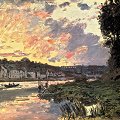 Get
Get  a high-quality picture of
The Seine at Bougival in the Evening for your computer or notebook. ‣
Based in Bougival from late 1869, Monet painted several views from Ile de Croissy, a key location for the future Impressionist movement. Here, he represents the Seine looking downstream, with the bridge at Bougival in the background. The horizon is also broken up by the Marly aqueduct which supplied water to the Chateau de Versailles. This depiction of evening, animated only by a single boat, stands in sharp contrast to other paintings of the location which feature the lively presence of oarsmen. Having become established in Bougival, the following year he married Camille-Leonie Doncieux, with Gustave Courbet and two of his first collectors as witnesses. His family, on the other hand, disapproved of this union and did not attend: Aunt Lecadre died a few days later.
a high-quality picture of
The Seine at Bougival in the Evening for your computer or notebook. ‣
Based in Bougival from late 1869, Monet painted several views from Ile de Croissy, a key location for the future Impressionist movement. Here, he represents the Seine looking downstream, with the bridge at Bougival in the background. The horizon is also broken up by the Marly aqueduct which supplied water to the Chateau de Versailles. This depiction of evening, animated only by a single boat, stands in sharp contrast to other paintings of the location which feature the lively presence of oarsmen. Having become established in Bougival, the following year he married Camille-Leonie Doncieux, with Gustave Courbet and two of his first collectors as witnesses. His family, on the other hand, disapproved of this union and did not attend: Aunt Lecadre died a few days later.
Train in the Countryside (1870)
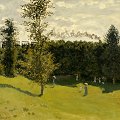 Get
Get  a high-quality picture of
Train in the Countryside for your computer or notebook. ‣
When the weather improved, Monet settled down to paint on the Ile de Croissy near Bougival. While there, he depicted the areas around Rueil and Chatou, now affected by the arrival of the Paris to Saint-Germain-en-Laye railway line; a train with its two-tier carriages can be seen in the background of the painting. This was the first occurrence of this theme in Monet's works, heralding a subject that would be close to his heart for the rest of his career. The train only appears here in the distance behind an English-style landscaped park, which is dotted with small middle-class figures. Yet the treatment of locomotive smoke is already very much in evidence. This painting marks the end of a particularly rich creative period around Bougival.
a high-quality picture of
Train in the Countryside for your computer or notebook. ‣
When the weather improved, Monet settled down to paint on the Ile de Croissy near Bougival. While there, he depicted the areas around Rueil and Chatou, now affected by the arrival of the Paris to Saint-Germain-en-Laye railway line; a train with its two-tier carriages can be seen in the background of the painting. This was the first occurrence of this theme in Monet's works, heralding a subject that would be close to his heart for the rest of his career. The train only appears here in the distance behind an English-style landscaped park, which is dotted with small middle-class figures. Yet the treatment of locomotive smoke is already very much in evidence. This painting marks the end of a particularly rich creative period around Bougival.
Meditation, Mrs. Monet Sitting on a Sofa (1871)
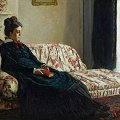 Get
Get  a high-quality picture of
Meditation, Mrs. Monet Sitting on a Sofa for your computer or notebook. ‣
Exiled to London in 1871, Monet initially found it hard, until he was introduced by Daubigny to the great art collector Durand-Ruel. With Pissarro he discovered the English landscape masters (Constable, Turner, among others) and immersed himself in the distinctive atmosphere of London. He tried to make good use of his stay in London by working on recent studies he had been able to bring with him. But he also began some works on site, including this portrait of Camille, who joined him shortly after his arrival. This small interior painting, rather unusual in Monet's career, verges on the genre scene. In it we see the first manifestations of his taste for things Japanese (the vase and fan on the mantelpiece), but above all, it is a charming image by the artist of his wife.
a high-quality picture of
Meditation, Mrs. Monet Sitting on a Sofa for your computer or notebook. ‣
Exiled to London in 1871, Monet initially found it hard, until he was introduced by Daubigny to the great art collector Durand-Ruel. With Pissarro he discovered the English landscape masters (Constable, Turner, among others) and immersed himself in the distinctive atmosphere of London. He tried to make good use of his stay in London by working on recent studies he had been able to bring with him. But he also began some works on site, including this portrait of Camille, who joined him shortly after his arrival. This small interior painting, rather unusual in Monet's career, verges on the genre scene. In it we see the first manifestations of his taste for things Japanese (the vase and fan on the mantelpiece), but above all, it is a charming image by the artist of his wife.
The Thames Below Westminster (1871)
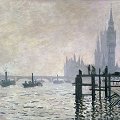 Get
Get  a high-quality picture of
The Thames Below Westminster for your computer or notebook. ‣
When he was staying in Trouville during the autumn of 1870, Monet decided to go to England, possibly to avoid being called up by the army. While there, he painted this view of the Thames and Parliament from Victoria Quay. The compositional scheme of this canvas is based predominantly on its network of horizontal and vertical lines, with the monuments' architecture echoing the boats on the river. Monet illustrates the London atmosphere by painting a picture that is dominated by grey tones, attenuated only by a pink light appearing on the horizon. It was in London that Daubigny introduced Monet to the art dealer Paul Durand-Ruel, who was there to open a gallery in 1870 and would become the artist's most faithful sponsor.
a high-quality picture of
The Thames Below Westminster for your computer or notebook. ‣
When he was staying in Trouville during the autumn of 1870, Monet decided to go to England, possibly to avoid being called up by the army. While there, he painted this view of the Thames and Parliament from Victoria Quay. The compositional scheme of this canvas is based predominantly on its network of horizontal and vertical lines, with the monuments' architecture echoing the boats on the river. Monet illustrates the London atmosphere by painting a picture that is dominated by grey tones, attenuated only by a pink light appearing on the horizon. It was in London that Daubigny introduced Monet to the art dealer Paul Durand-Ruel, who was there to open a gallery in 1870 and would become the artist's most faithful sponsor.
Lilacs, Grey Weather (1872)
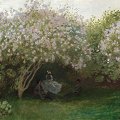 Get
Get  a high-quality picture of
Lilacs, Grey Weather for your computer or notebook. ‣
Following periods spent in England and Holland, Monet went back to France and tried to set up home outside Paris. He found what he wanted in a house in Argenteuil, near to the railway station and the Seine. The spring of 1872 brought magnificent blossoms to the orchards and gardens and so Monet spent much time in his own garden. There he painted some figures among the flowers: Camille on the left, along with two other individuals. Monet and Sisley also spent time together painting the features surrounding the house in Argenteuil. But the garden and its lilacs became, for Monet in particular, the means of treating a subject under various light conditions. Detailed precision thus gives way to the power of the imagination, and the blending of tones makes the figures and vegetation merge into one another.
a high-quality picture of
Lilacs, Grey Weather for your computer or notebook. ‣
Following periods spent in England and Holland, Monet went back to France and tried to set up home outside Paris. He found what he wanted in a house in Argenteuil, near to the railway station and the Seine. The spring of 1872 brought magnificent blossoms to the orchards and gardens and so Monet spent much time in his own garden. There he painted some figures among the flowers: Camille on the left, along with two other individuals. Monet and Sisley also spent time together painting the features surrounding the house in Argenteuil. But the garden and its lilacs became, for Monet in particular, the means of treating a subject under various light conditions. Detailed precision thus gives way to the power of the imagination, and the blending of tones makes the figures and vegetation merge into one another.
Regatta at Argenteuil (1872)
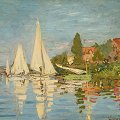 Get
Get  a high-quality picture of
Regatta at Argenteuil for your computer or notebook. ‣
Monet's boat-studio allowed him to add to the views of the Seine around Argenteuil, which were entirely executed en plein air. The painter described the studio quite simply as 'a barge with a cabin where I had just enough space to set up my easel'. He was thus able to paint this canvas which features in warm tones the small houses in front of the boat-builder's yard at Petit-Gennevilliers. This double image, of real life and its reflection, shows a regular, concise system of brushstrokes. The background motifs, the road bridge and the house with dormer window, are superficially sketched. Monet came closer than ever to the traditional marine format with this canvas and other views of the Seine at Argenteuil.
a high-quality picture of
Regatta at Argenteuil for your computer or notebook. ‣
Monet's boat-studio allowed him to add to the views of the Seine around Argenteuil, which were entirely executed en plein air. The painter described the studio quite simply as 'a barge with a cabin where I had just enough space to set up my easel'. He was thus able to paint this canvas which features in warm tones the small houses in front of the boat-builder's yard at Petit-Gennevilliers. This double image, of real life and its reflection, shows a regular, concise system of brushstrokes. The background motifs, the road bridge and the house with dormer window, are superficially sketched. Monet came closer than ever to the traditional marine format with this canvas and other views of the Seine at Argenteuil.
The Port at Argenteuil (1872)
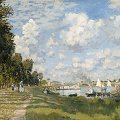 Get
Get  a high-quality picture of
The Port at Argenteuil for your computer or notebook. ‣
Monet faithfully depicted the Argenteuil countryside, presenting a truly panoramic view: the promenade lined with plane trees, the towpath, and the gently sloping riverbank, where people strolling by paused, while others watched the oarsmen. The hot bathhouse moored to the bank can be discerned, along with the washing boats in the background. The painter allows himself a few liberties with real life, however, in his treatment of the road bridge (he only keeps five of the seven arches) and the tollbooth (taller than life-size). This particularly accomplished work was the beginning of a rich series of paintings on the theme of the Seine at Argenteuil.
a high-quality picture of
The Port at Argenteuil for your computer or notebook. ‣
Monet faithfully depicted the Argenteuil countryside, presenting a truly panoramic view: the promenade lined with plane trees, the towpath, and the gently sloping riverbank, where people strolling by paused, while others watched the oarsmen. The hot bathhouse moored to the bank can be discerned, along with the washing boats in the background. The painter allows himself a few liberties with real life, however, in his treatment of the road bridge (he only keeps five of the seven arches) and the tollbooth (taller than life-size). This particularly accomplished work was the beginning of a rich series of paintings on the theme of the Seine at Argenteuil.
The Promenade at Argenteuil (1872)
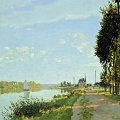 Get
Get  a high-quality picture of
The Promenade at Argenteuil for your computer or notebook. ‣
After he had returned from the municipal exhibition in Rouen, and until the end of 1872, the most important part of Monet's artistic output took place in Argenteuil. Most of his work was done on the right bank of the Seine, the Argenteuil side, painted facing the setting sun beyond the trees of the promenade. The road and rail bridges, the Seine, the sky of Ile-de-France, and the promenade's trees would become the key subjects in Monet's work in Argenteuil, forming the most distinctive motifs of this highpoint of Impressionist painting. Here, the painter focuses his attention on the physical features, especially the promenade and the river, but typically at the same time he suggests a human presence through small details.
a high-quality picture of
The Promenade at Argenteuil for your computer or notebook. ‣
After he had returned from the municipal exhibition in Rouen, and until the end of 1872, the most important part of Monet's artistic output took place in Argenteuil. Most of his work was done on the right bank of the Seine, the Argenteuil side, painted facing the setting sun beyond the trees of the promenade. The road and rail bridges, the Seine, the sky of Ile-de-France, and the promenade's trees would become the key subjects in Monet's work in Argenteuil, forming the most distinctive motifs of this highpoint of Impressionist painting. Here, the painter focuses his attention on the physical features, especially the promenade and the river, but typically at the same time he suggests a human presence through small details.
The Railway Station at Argenteuil (1872)
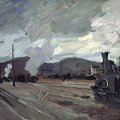 Get
Get  a high-quality picture of
The Railway Station at Argenteuil for your computer or notebook. ‣
In Argenteuil, Monet painted the places which were among the key images of Impressionism: the town's bridges and the Seine basin. Sometimes though, the painter left the river in order to represent other subjects in the town itself: the houses around his home, the town's main streets, and also the station at Argenteuil with the Sannois hills in the landscape's background. Here Monet was able to gain access to railway engines with tall funnels. This painting, prefiguring the views of the Gare Saint-Lazare he would paint five years later, allowed him to play with the movement created by the wind as it blew the smoke curls: the white plume is then contrasted with the blackness of the locomotives waiting in the station.
a high-quality picture of
The Railway Station at Argenteuil for your computer or notebook. ‣
In Argenteuil, Monet painted the places which were among the key images of Impressionism: the town's bridges and the Seine basin. Sometimes though, the painter left the river in order to represent other subjects in the town itself: the houses around his home, the town's main streets, and also the station at Argenteuil with the Sannois hills in the landscape's background. Here Monet was able to gain access to railway engines with tall funnels. This painting, prefiguring the views of the Gare Saint-Lazare he would paint five years later, allowed him to play with the movement created by the wind as it blew the smoke curls: the white plume is then contrasted with the blackness of the locomotives waiting in the station.
The Red Kerchief, Portrait of Mrs. Monet (1873)
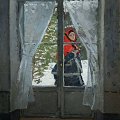 Get
Get  a high-quality picture of
The Red Kerchief, Portrait of Mrs. Monet for your computer or notebook. ‣
After settling in Argenteuil, Monet set out to paint the surrounding countryside, but occasionally retreated to his home where he found familiar subjects. This portrait, which is apparently of Camille wearing a red cape, is a case in point. The artist finds perfect harmony in his view of the subject, the spontaneous expression of the female figure, and the simplicity of effects applied. This highly original painting allowed him to prove his talent for playing with the light and transparency of the glass panes and curtains. He went for a composition that was subtly decentred, disrupting the model's solemnity. In its portrayal of the contemporary middle classes, this female portrait is in the tradition of Femmes aux jardins. For a long time, Monet held on to this painting of his wife: he kept the canvas until 1920.
a high-quality picture of
The Red Kerchief, Portrait of Mrs. Monet for your computer or notebook. ‣
After settling in Argenteuil, Monet set out to paint the surrounding countryside, but occasionally retreated to his home where he found familiar subjects. This portrait, which is apparently of Camille wearing a red cape, is a case in point. The artist finds perfect harmony in his view of the subject, the spontaneous expression of the female figure, and the simplicity of effects applied. This highly original painting allowed him to prove his talent for playing with the light and transparency of the glass panes and curtains. He went for a composition that was subtly decentred, disrupting the model's solemnity. In its portrayal of the contemporary middle classes, this female portrait is in the tradition of Femmes aux jardins. For a long time, Monet held on to this painting of his wife: he kept the canvas until 1920.
The Railway Bridge at Argenteuil (1874)
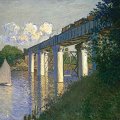 Get
Get  a high-quality picture of
The Railway Bridge at Argenteuil for your computer or notebook. ‣
Two constructions span the Seine at Argenteuil: a toll road bridge and, 500 metres upstream, a railway bridge. Both of them were destroyed in 1870, but their rapid reconstruction allowed Monet to make it a subject for his paintings. So he painted each of them: the railway bridge is sometimes barely perceptible between the arches of the road bridge, and sometimes, as is the case here, is treated in its own right, highlighting the monumental nature of industrial architecture. It was during this period that the Impressionist painters' group was formed officially in the first Impressionist exhibition, which opened in Nadar's studio on 15 April 1874. The painters were then in frequent contact with each other. Most notably, Manet and Renoir came to Argenteuil to paint with Monet.
a high-quality picture of
The Railway Bridge at Argenteuil for your computer or notebook. ‣
Two constructions span the Seine at Argenteuil: a toll road bridge and, 500 metres upstream, a railway bridge. Both of them were destroyed in 1870, but their rapid reconstruction allowed Monet to make it a subject for his paintings. So he painted each of them: the railway bridge is sometimes barely perceptible between the arches of the road bridge, and sometimes, as is the case here, is treated in its own right, highlighting the monumental nature of industrial architecture. It was during this period that the Impressionist painters' group was formed officially in the first Impressionist exhibition, which opened in Nadar's studio on 15 April 1874. The painters were then in frequent contact with each other. Most notably, Manet and Renoir came to Argenteuil to paint with Monet.
The Coal-Dockers (1875)
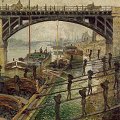 Get
Get  a high-quality picture of
The Coal-Dockers for your computer or notebook. ‣
From the train that took him to Argenteuil, Monet observed the comings and goings of the people whose job it was to carry coal to the Clichy gasworks at the foot of Pont d'Asnieres. One day he stopped to capture on canvas the fascinating movement of the coalmen, keeping their balance as they made their way along narrow planks. This sudden incursion into the industrial era, coming together with the gardens and the world of the Argenteuil oarsmen, may be surprising. In fact, while Monet was not dissociating himself from realist themes, he seemed to deliberately gloss over some of the signs of industrialization, notably the factory chimneys around Argenteuil, which are absent from his paintings and yet present in Manet's works. This unique work was, however, considered by its creator to be representative of his output, as he presented it at the Impressionist sale in 1875.
a high-quality picture of
The Coal-Dockers for your computer or notebook. ‣
From the train that took him to Argenteuil, Monet observed the comings and goings of the people whose job it was to carry coal to the Clichy gasworks at the foot of Pont d'Asnieres. One day he stopped to capture on canvas the fascinating movement of the coalmen, keeping their balance as they made their way along narrow planks. This sudden incursion into the industrial era, coming together with the gardens and the world of the Argenteuil oarsmen, may be surprising. In fact, while Monet was not dissociating himself from realist themes, he seemed to deliberately gloss over some of the signs of industrialization, notably the factory chimneys around Argenteuil, which are absent from his paintings and yet present in Manet's works. This unique work was, however, considered by its creator to be representative of his output, as he presented it at the Impressionist sale in 1875.
The Walk, Woman with a Parasol (1875)
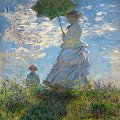 Get
Get  a high-quality picture of
The Walk, Woman with a Parasol for your computer or notebook. ‣
Monet presents us with a striking image in this work: a low-angle composition with the figure of his wife Camille standing out boldly against the sky. She is captured apparently at the moment when she becomes aware of the painter's presence and turns towards him. A sense of movement is produced by the grey veil covering part of her face and by the folds of her dress. This shimmering figure thus forms a stark contrast to the far more static figure of their son Jean in the background. The two figures seem almost like strangers to each other. This canvas, presented to the Second Impressionist Exhibition, employs a recurrent motif in Monet's work - a woman with a parasol.
a high-quality picture of
The Walk, Woman with a Parasol for your computer or notebook. ‣
Monet presents us with a striking image in this work: a low-angle composition with the figure of his wife Camille standing out boldly against the sky. She is captured apparently at the moment when she becomes aware of the painter's presence and turns towards him. A sense of movement is produced by the grey veil covering part of her face and by the folds of her dress. This shimmering figure thus forms a stark contrast to the far more static figure of their son Jean in the background. The two figures seem almost like strangers to each other. This canvas, presented to the Second Impressionist Exhibition, employs a recurrent motif in Monet's work - a woman with a parasol.
Turkeys (1876)
 Get
Get  a high-quality picture of
Turkeys for your computer or notebook. ‣
In the late summer of 1876, Monet was given his first large-scale commission by Ernest Hoschede, a Parisian textile merchant. Hoschede wanted the painter to make large panels for the grand salon in the Chateau de Rottembourg, which his wife Alice had inherited. So Monet left Camille in Argenteuil with no means of support while he worked (between the summer of 1876 and the beginning of the following year) on the four decorative panels that had been commissioned. Monet was able to give free rein to his imagination for this commission. He designed panels with a bold composition: here, the turkeys seem to appear suddenly from outside the canvas. This decoration, presented at the 1877 Impressionist Exhibition, would remain unfinished.
a high-quality picture of
Turkeys for your computer or notebook. ‣
In the late summer of 1876, Monet was given his first large-scale commission by Ernest Hoschede, a Parisian textile merchant. Hoschede wanted the painter to make large panels for the grand salon in the Chateau de Rottembourg, which his wife Alice had inherited. So Monet left Camille in Argenteuil with no means of support while he worked (between the summer of 1876 and the beginning of the following year) on the four decorative panels that had been commissioned. Monet was able to give free rein to his imagination for this commission. He designed panels with a bold composition: here, the turkeys seem to appear suddenly from outside the canvas. This decoration, presented at the 1877 Impressionist Exhibition, would remain unfinished.
Exterior of Saint-Lazare Station (The Signal) (1877)
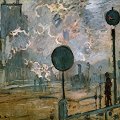 Get
Get  a high-quality picture of
Exterior of Saint-Lazare Station (The Signal) for your computer or notebook. ‣
Not long after completing his first works on this subject, Monet showed seven Gare Saint-Lazare paintings at the Third Impressionist exhibition in 1877. The reception given to them by most of the press was hostile. But commentators at the time highlighted a crucial aspect to these paintings: synaesthesia, or the association of several different types of sensory experience. They describe the paintings as giving the impression of several locomotives whistling simultaneously, or as reflecting how travellers experience the noise of engines at arrival or departure times. This blend of sensations also finds expression in the deafening fog of engine smoke that enshrouds the area around the station, revealing only the red signal.
a high-quality picture of
Exterior of Saint-Lazare Station (The Signal) for your computer or notebook. ‣
Not long after completing his first works on this subject, Monet showed seven Gare Saint-Lazare paintings at the Third Impressionist exhibition in 1877. The reception given to them by most of the press was hostile. But commentators at the time highlighted a crucial aspect to these paintings: synaesthesia, or the association of several different types of sensory experience. They describe the paintings as giving the impression of several locomotives whistling simultaneously, or as reflecting how travellers experience the noise of engines at arrival or departure times. This blend of sensations also finds expression in the deafening fog of engine smoke that enshrouds the area around the station, revealing only the red signal.
Chrysanthemums (1878)
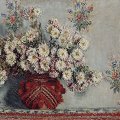 Get
Get  a high-quality picture of
Chrysanthemums for your computer or notebook. ‣
Bad weather days, precluding work in the open air, generated a significant output of fruit and flower paintings. Monet adapted his technique for this different theme: he observed the subject for a long period, and then scrupulously reproduced every detail. The decentring of the main motif is the only element of free expression in this traditional composition, giving it an original arrangement. The line of the table is reflected in the material covering the vase, and the floral motif on the wallpaper echoes the main bunch of flowers. Monet's interest in flowers was really taking control in his life, a trend continuing through to the gardens at Giverny. At the time, he was growing chrysanthemums, a flower that was fashionable in the late 19th century, having been newly imported from the Far East at the end of the previous century.
a high-quality picture of
Chrysanthemums for your computer or notebook. ‣
Bad weather days, precluding work in the open air, generated a significant output of fruit and flower paintings. Monet adapted his technique for this different theme: he observed the subject for a long period, and then scrupulously reproduced every detail. The decentring of the main motif is the only element of free expression in this traditional composition, giving it an original arrangement. The line of the table is reflected in the material covering the vase, and the floral motif on the wallpaper echoes the main bunch of flowers. Monet's interest in flowers was really taking control in his life, a trend continuing through to the gardens at Giverny. At the time, he was growing chrysanthemums, a flower that was fashionable in the late 19th century, having been newly imported from the Far East at the end of the previous century.
The Rue Montorgueil, 30th of June 1878 (1878)
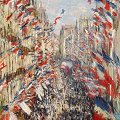 Get
Get  a high-quality picture of
The Rue Montorgueil, 30th of June 1878 for your computer or notebook. ‣
Back in Paris in early 1878 after the birth of his son Michel, Monet was concerned about the increasingly fragile state of Camille's health. All the same, he went off in search of new subjects in Paris. The national holiday on 30 June 1878, organized to celebrate the success of the Exposition Universelle, gave him the opportunity to paint the capital awash with colour and once more flying the tricolour flag. As Monet explained, 'I loved flags. On the first national holiday on 30 June, I was walking along Rue Montorgueil with the tools of my trade; the street was decked with flags and crowded with people; I spotted a balcony, so I went up and asked permission to paint there, which was granted. Then I came back down again, incognito!' The resulting hastily executed canvas shows the seductive effect for Monet of flags fluttering in the wind.
a high-quality picture of
The Rue Montorgueil, 30th of June 1878 for your computer or notebook. ‣
Back in Paris in early 1878 after the birth of his son Michel, Monet was concerned about the increasingly fragile state of Camille's health. All the same, he went off in search of new subjects in Paris. The national holiday on 30 June 1878, organized to celebrate the success of the Exposition Universelle, gave him the opportunity to paint the capital awash with colour and once more flying the tricolour flag. As Monet explained, 'I loved flags. On the first national holiday on 30 June, I was walking along Rue Montorgueil with the tools of my trade; the street was decked with flags and crowded with people; I spotted a balcony, so I went up and asked permission to paint there, which was granted. Then I came back down again, incognito!' The resulting hastily executed canvas shows the seductive effect for Monet of flags fluttering in the wind.
Breakup of Ice, Grey Weather (1880)
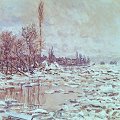 Get
Get  a high-quality picture of
Breakup of Ice, Grey Weather for your computer or notebook. ‣
This view, very close chronologically to the exact moment when the ice broke, is one of the first painted by Monet after the event. It depicts the expanse of ice stretching out to the end of the orchard near the port. As the ice floes were carried along they devastated the gardens in Vetheuil, ripping up fences and damaging trees. The small islands on the Seine disappeared, and numerous poplars were brought down. In these views of the ice breaking up, Monet more often than not chose a point of view perpendicular to the flow of the river. Thus the Seine in the foreground covers the full width of the canvas; the riverbank and the hillside form staggered parallel lines, broken only by the verticals or diagonals of bent poplars and the church towers in the village.
a high-quality picture of
Breakup of Ice, Grey Weather for your computer or notebook. ‣
This view, very close chronologically to the exact moment when the ice broke, is one of the first painted by Monet after the event. It depicts the expanse of ice stretching out to the end of the orchard near the port. As the ice floes were carried along they devastated the gardens in Vetheuil, ripping up fences and damaging trees. The small islands on the Seine disappeared, and numerous poplars were brought down. In these views of the ice breaking up, Monet more often than not chose a point of view perpendicular to the flow of the river. Thus the Seine in the foreground covers the full width of the canvas; the riverbank and the hillside form staggered parallel lines, broken only by the verticals or diagonals of bent poplars and the church towers in the village.
Breakup of Ice (1880)
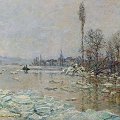 Get
Get  a high-quality picture of
Breakup of Ice for your computer or notebook. ‣
From the riverbank at Vetheuil, Monet looked upstream to the houses at Lavacourt, situated on the opposite bank. In the distance, to the left, the church tower of Saint-Martin-la Garenne, outlined against the hills, can be discerned. This canvas was done at a slightly later date than the first views executed after the ice breakup. The jagged ice floes, given emphasis by impasto colours, are less numerous. They have also been thrown up onto the banks, as can be seen from the pile in the left foreground. The water has lost its devastating power, becoming calmer. The river, now navigable once more, witnessed the return of a barge with small figures on board. Monet's boat-studio, moored on the Seine at that time, only sustained minor damage in the ice breakup.
a high-quality picture of
Breakup of Ice for your computer or notebook. ‣
From the riverbank at Vetheuil, Monet looked upstream to the houses at Lavacourt, situated on the opposite bank. In the distance, to the left, the church tower of Saint-Martin-la Garenne, outlined against the hills, can be discerned. This canvas was done at a slightly later date than the first views executed after the ice breakup. The jagged ice floes, given emphasis by impasto colours, are less numerous. They have also been thrown up onto the banks, as can be seen from the pile in the left foreground. The water has lost its devastating power, becoming calmer. The river, now navigable once more, witnessed the return of a barge with small figures on board. Monet's boat-studio, moored on the Seine at that time, only sustained minor damage in the ice breakup.
Sunset on the Seine, Winter Effect (1880)
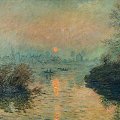 Get
Get  a high-quality picture of
Sunset on the Seine, Winter Effect for your computer or notebook. ‣
While continuing to develop a 'more sober and bourgeois' style of painting intended for the Salon, Monet was at the same time giving free rein to his feelings. As with Impression, soleil levant (Impression: Sunrise), here he conveys the impression felt at a particular moment (sunset), focusing on its ephemeral nature. The red glow of the sun is all the more vibrant as it will soon have disappeared beyond the horizon. The deliberately sketchy appearance would indicate that it has been rapidly executed. Fragmented brushstrokes evoke the reflections on the water, using the same colour as the setting sun. The play of light leads into more nuanced tonalities (from the red ball of fire to the pink wintry sky). In this way, the sun - the subject and focal point of the picture - forms a contrast to the houses at Lavacourt which are superficially sketched.
a high-quality picture of
Sunset on the Seine, Winter Effect for your computer or notebook. ‣
While continuing to develop a 'more sober and bourgeois' style of painting intended for the Salon, Monet was at the same time giving free rein to his feelings. As with Impression, soleil levant (Impression: Sunrise), here he conveys the impression felt at a particular moment (sunset), focusing on its ephemeral nature. The red glow of the sun is all the more vibrant as it will soon have disappeared beyond the horizon. The deliberately sketchy appearance would indicate that it has been rapidly executed. Fragmented brushstrokes evoke the reflections on the water, using the same colour as the setting sun. The play of light leads into more nuanced tonalities (from the red ball of fire to the pink wintry sky). In this way, the sun - the subject and focal point of the picture - forms a contrast to the houses at Lavacourt which are superficially sketched.
Low Tide at Pourville (1882)
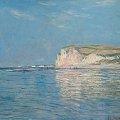 Get
Get  a high-quality picture of
Low Tide at Pourville for your computer or notebook. ‣
During his first stay in Normandy, Monet moved on quickly from Dieppe and set up in Pourville, a small fishing village three miles from the town. As summer bathing had proved so successful in this seaside resort, a villa had been erected at the west end of the beach and the artist took lodgings there. Monet represented the beauty of the landscapes around the village, with its high cliffs gouged by steep hanging valleys. Here he depicts the Amont cliff at the eastern end of Pourville beach, and the coastline stretching from Dieppe to Le Treport in the background. He would return to this location at a later date, spurred on by the success of the 35 works he showed during the Seventh Exhibition of Independent Artists, especially his Normandy seascapes.
a high-quality picture of
Low Tide at Pourville for your computer or notebook. ‣
During his first stay in Normandy, Monet moved on quickly from Dieppe and set up in Pourville, a small fishing village three miles from the town. As summer bathing had proved so successful in this seaside resort, a villa had been erected at the west end of the beach and the artist took lodgings there. Monet represented the beauty of the landscapes around the village, with its high cliffs gouged by steep hanging valleys. Here he depicts the Amont cliff at the eastern end of Pourville beach, and the coastline stretching from Dieppe to Le Treport in the background. He would return to this location at a later date, spurred on by the success of the 35 works he showed during the Seventh Exhibition of Independent Artists, especially his Normandy seascapes.
Walk on the Cliff at Pourville (1882)
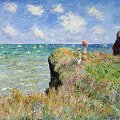 Get
Get  a high-quality picture of
Walk on the Cliff at Pourville for your computer or notebook. ‣
Monet was unhappy in Poissy, where he lived from this time with Anne Hoschede, and wanted to take a trip to Normandy in the early summer of 1882. So he rented a house where he could bring all of his family to join him. He could not wait to rediscover the subjects he already knew well: 'the countryside is wonderful at the moment and I long to get back to it.' This allowed Monet to paint the east side of Val Saint-Nicolas on this canvas, inserting two female figures into the landscape, possibly Madame Hoschede and one of her daughters; easy access to the spot gave his models the opportunity to pose there. But his initial enthusiasm and being reunited with his former circle were soon replaced by a mediocre summer in which he waited impatiently for sunny spells, and his work proved difficult.
a high-quality picture of
Walk on the Cliff at Pourville for your computer or notebook. ‣
Monet was unhappy in Poissy, where he lived from this time with Anne Hoschede, and wanted to take a trip to Normandy in the early summer of 1882. So he rented a house where he could bring all of his family to join him. He could not wait to rediscover the subjects he already knew well: 'the countryside is wonderful at the moment and I long to get back to it.' This allowed Monet to paint the east side of Val Saint-Nicolas on this canvas, inserting two female figures into the landscape, possibly Madame Hoschede and one of her daughters; easy access to the spot gave his models the opportunity to pose there. But his initial enthusiasm and being reunited with his former circle were soon replaced by a mediocre summer in which he waited impatiently for sunny spells, and his work proved difficult.
Beach at Etretat (1883)
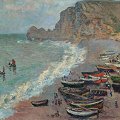 Get
Get  a high-quality picture of
Beach at Etretat for your computer or notebook. ‣
While Monet was staying at Etretat, he visited a location that had often been frequented by 19th century painters (Delacroix, Courbet, Corot and Boudin). Here, he depicts the view from the path that ascends the Aval cliff at Etretat, with the boats on the seafront and, further on, the beach with the Porte d'Amont which Maupassant described as 'a strange rounded shape, with a hole pierced through it, almost like a huge elephant sticking its trunk in the water'. Monet also likened the location to a living form, describing 'these grand arches, like two legs of the cliff walking into the sea'. The sky and the sea held equal significance in the locale's scenic attraction for painters. The calm sea is prominent here, animated only by two boats and figures that look tiny because of the bird's eye view.
a high-quality picture of
Beach at Etretat for your computer or notebook. ‣
While Monet was staying at Etretat, he visited a location that had often been frequented by 19th century painters (Delacroix, Courbet, Corot and Boudin). Here, he depicts the view from the path that ascends the Aval cliff at Etretat, with the boats on the seafront and, further on, the beach with the Porte d'Amont which Maupassant described as 'a strange rounded shape, with a hole pierced through it, almost like a huge elephant sticking its trunk in the water'. Monet also likened the location to a living form, describing 'these grand arches, like two legs of the cliff walking into the sea'. The sky and the sea held equal significance in the locale's scenic attraction for painters. The calm sea is prominent here, animated only by two boats and figures that look tiny because of the bird's eye view.
A Field of Tulips in Holland (1886)
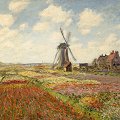 Get
Get  a high-quality picture of
A Field of Tulips in Holland for your computer or notebook. ‣
Following his first trip to Holland in 1871, Monet went back there in the spring of 1886 for a brief stay, in The Hague, of just under a fortnight. At that time, he discovered the tulip fields between Leiden and Haarlem, which inspired five canvases. To begin with, he felt impotent in the face of nature's beauty, saying 'it cannot be rendered with our paltry colours', but then - fascinated by this motif - he attempted to reproduce it. He constructed a geometric landscape, divided into square sections by the canals, juxtaposing differently coloured areas with vivid tonalities. For Huysmans, this painting created 'a real feast for the eyes' when it was shown at the Fifth International Exhibition of Painting and Sculpture in 1886, at which Monet met with success in selling all the paintings he exhibited.
a high-quality picture of
A Field of Tulips in Holland for your computer or notebook. ‣
Following his first trip to Holland in 1871, Monet went back there in the spring of 1886 for a brief stay, in The Hague, of just under a fortnight. At that time, he discovered the tulip fields between Leiden and Haarlem, which inspired five canvases. To begin with, he felt impotent in the face of nature's beauty, saying 'it cannot be rendered with our paltry colours', but then - fascinated by this motif - he attempted to reproduce it. He constructed a geometric landscape, divided into square sections by the canals, juxtaposing differently coloured areas with vivid tonalities. For Huysmans, this painting created 'a real feast for the eyes' when it was shown at the Fifth International Exhibition of Painting and Sculpture in 1886, at which Monet met with success in selling all the paintings he exhibited.
Rocks at Port-Coton, The Lion (1886)
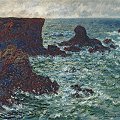 Get
Get  a high-quality picture of
Rocks at Port-Coton, The Lion for your computer or notebook. ‣
When he arrived at Belle-Ile-en-Mer, Monet was initially unsettled by his first experience of the Atlantic Ocean. 'It is wonderful, but as it is so different from the Channel, I shall have to become acquainted with this form of nature: I will need some time to know how to approach it all.' So the painter executed numerous studies which convey his wonder at the sea and fabulous rocks on this coastline, among them the twisted formations rising up from the water at Port-Coton. He represents the same subjects repeatedly, observing them from various positions and in different types of weather. These works mark an important stage in Monet's output, showing him to be a painter whose approach to his subject was deliberate and systematic.
a high-quality picture of
Rocks at Port-Coton, The Lion for your computer or notebook. ‣
When he arrived at Belle-Ile-en-Mer, Monet was initially unsettled by his first experience of the Atlantic Ocean. 'It is wonderful, but as it is so different from the Channel, I shall have to become acquainted with this form of nature: I will need some time to know how to approach it all.' So the painter executed numerous studies which convey his wonder at the sea and fabulous rocks on this coastline, among them the twisted formations rising up from the water at Port-Coton. He represents the same subjects repeatedly, observing them from various positions and in different types of weather. These works mark an important stage in Monet's output, showing him to be a painter whose approach to his subject was deliberate and systematic.
The Cote Sauvage (1886)
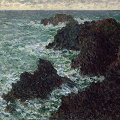 Get
Get  a high-quality picture of
The Cote Sauvage for your computer or notebook. ‣
Monet wanted to go to Brittany to work during the summer of 1886, and, so that he could be alone, he decided to go to Belle-Ile-en-Mer, opposite the Morbihan coast. There he discovered the 'Wild Coast' that opens onto the Atlantic Ocean; with its 'rocks and wonderful grottos, it is bleak and demonic, but superb'. So he attempted to render the various aspects of this wild coastline in all weathers, painting five canvases around this motif. This painting, the only one in landscape format, allows greater scale for his composition and more importantly, more space for the sea. The horizon line being at the very top indicates that, rather than the sky, the theme here is the way in which this rugged coastline has been shaped by the earth and sea as a result of complex, interrelated processes.
a high-quality picture of
The Cote Sauvage for your computer or notebook. ‣
Monet wanted to go to Brittany to work during the summer of 1886, and, so that he could be alone, he decided to go to Belle-Ile-en-Mer, opposite the Morbihan coast. There he discovered the 'Wild Coast' that opens onto the Atlantic Ocean; with its 'rocks and wonderful grottos, it is bleak and demonic, but superb'. So he attempted to render the various aspects of this wild coastline in all weathers, painting five canvases around this motif. This painting, the only one in landscape format, allows greater scale for his composition and more importantly, more space for the sea. The horizon line being at the very top indicates that, rather than the sky, the theme here is the way in which this rugged coastline has been shaped by the earth and sea as a result of complex, interrelated processes.
In the Norvegienne (1887)
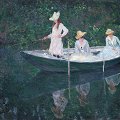 Get
Get  a high-quality picture of
In the Norvegienne for your computer or notebook. ‣
Fresh from his success at the International Exhibition, Monet went back to Giverny and invited his fellow artists to join him there. He then spent most of the summer months painting figures in the open air within a landscape. This is how he came to paint Germaine, Suzanne and Blanche, the daughters of his companion, Alice Hoschede, on a small rowing boat on the banks of the River Epte. Dressed in bright outfits, they are busy fishing with rods, an activity that Monet himself had taught them. The sky does not feature in this canvas, the main theme being the study of light playing on water. The figures are impersonal, shifting the whole focus to the river and the reflection, which, as it were, forms a duplicate of the subject on the water's surface.
a high-quality picture of
In the Norvegienne for your computer or notebook. ‣
Fresh from his success at the International Exhibition, Monet went back to Giverny and invited his fellow artists to join him there. He then spent most of the summer months painting figures in the open air within a landscape. This is how he came to paint Germaine, Suzanne and Blanche, the daughters of his companion, Alice Hoschede, on a small rowing boat on the banks of the River Epte. Dressed in bright outfits, they are busy fishing with rods, an activity that Monet himself had taught them. The sky does not feature in this canvas, the main theme being the study of light playing on water. The figures are impersonal, shifting the whole focus to the river and the reflection, which, as it were, forms a duplicate of the subject on the water's surface.
Poplars at Giverny (1888)
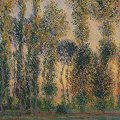 Get
Get  a high-quality picture of
Poplars at Giverny for your computer or notebook. ‣
From spring to autumn 1891, Monet devoted himself to the treatment of a
new subject, the only one he painted throughout this period: poplar trees.
He produced a group of about 20 canvases depicting the trees planted on the
edge of a marsh situated on the left bank of the Epte, two kilometres
upstream from Giverny. The site had been put up for sale during the summer,
and the plan was to cut down these trees. After the mayor had refused to
grant a reprieve, Monet found himself forced to pay a sum of money to the
timber merchant to stop the trees being felled before he had finished the
series. Having set up in a boat, he made the most of the perspective effect
offered by the line of poplars, which followed the winding course of the
river upstream, forming a kind of large 'S'. He was then able to form
decorative compositions that were built around curved lines and
counterbalanced by the verticals of the trunks. Monet painted several
sub-series, reproducing the trees face-on and reflected in the river, but
sometimes he reduced the motif to the simple vertical line of the trunks.
With this new series, the painter repeated the approach he had undertaken
the previous year with the Meules. The titles echo those he had chosen for
that first series. The aim was identical in both cases: to depict the
variations in light and seasons. The 'instantaneity' of these paintings is
meant to convey the impression one feels when encountering the subject at a
precise moment. The poplars series was the first to be exhibited without
any other painting, as a complete entity in itself, when it was shown in
the Durand-Ruel gallery in 1892.
a high-quality picture of
Poplars at Giverny for your computer or notebook. ‣
From spring to autumn 1891, Monet devoted himself to the treatment of a
new subject, the only one he painted throughout this period: poplar trees.
He produced a group of about 20 canvases depicting the trees planted on the
edge of a marsh situated on the left bank of the Epte, two kilometres
upstream from Giverny. The site had been put up for sale during the summer,
and the plan was to cut down these trees. After the mayor had refused to
grant a reprieve, Monet found himself forced to pay a sum of money to the
timber merchant to stop the trees being felled before he had finished the
series. Having set up in a boat, he made the most of the perspective effect
offered by the line of poplars, which followed the winding course of the
river upstream, forming a kind of large 'S'. He was then able to form
decorative compositions that were built around curved lines and
counterbalanced by the verticals of the trunks. Monet painted several
sub-series, reproducing the trees face-on and reflected in the river, but
sometimes he reduced the motif to the simple vertical line of the trunks.
With this new series, the painter repeated the approach he had undertaken
the previous year with the Meules. The titles echo those he had chosen for
that first series. The aim was identical in both cases: to depict the
variations in light and seasons. The 'instantaneity' of these paintings is
meant to convey the impression one feels when encountering the subject at a
precise moment. The poplars series was the first to be exhibited without
any other painting, as a complete entity in itself, when it was shown in
the Durand-Ruel gallery in 1892.
Antibes, Afternoon Effect (1888)
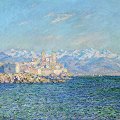 Get
Get  a high-quality picture of
Antibes, Afternoon Effect for your computer or notebook. ‣
In early 1888 Monet went back once more to the Mediterranean shores, four years after his first trip to the Riviera. He stayed at Chateau de la Pinede, a noble residence that had been turned into an artists' centre: he was welcomed there on the recommendation of Maupassant, whom he met on one of his trips to the Normandy coast. After scouting around the area for two days, he found a few subjects, especially the views of Antibes town from Juan-les-Pins. 'I am painting Antibes as a small fortified town glistening golden in the sun, and standing out against the beautiful blue and pink mountains.' When his initial attempts presented him with problems, Monet immediately became fixed on the idea of returning to Giverny, but he ended up staying in Antibes for five months.
a high-quality picture of
Antibes, Afternoon Effect for your computer or notebook. ‣
In early 1888 Monet went back once more to the Mediterranean shores, four years after his first trip to the Riviera. He stayed at Chateau de la Pinede, a noble residence that had been turned into an artists' centre: he was welcomed there on the recommendation of Maupassant, whom he met on one of his trips to the Normandy coast. After scouting around the area for two days, he found a few subjects, especially the views of Antibes town from Juan-les-Pins. 'I am painting Antibes as a small fortified town glistening golden in the sun, and standing out against the beautiful blue and pink mountains.' When his initial attempts presented him with problems, Monet immediately became fixed on the idea of returning to Giverny, but he ended up staying in Antibes for five months.
The Creuse at Sunset (1889)
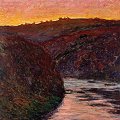 Get
Get  a high-quality picture of
The Creuse at Sunset for your computer or notebook. ‣
In a letter to Berthe Morisot, Monet described the Creuse Valley thus: 'It is wonderful here, with a fearful savagery that reminds me of Belle-Ile. I came here on a trip with some friends and was filled with such wonder that I am still here a good month later.' For this picture, he took up position on the slope that gave him a bird's eye view of the confluence of the two Creuse rivers, located behind the left hand mass of rock. The hills and the water share the space at the expense of the sky. The distinctive palette conveys the time of day chosen by the painter: 'In the evening the sky brightened up and I went to do a sunset.' The intensity of colours is audacious. The Creuse paintings are yet another demonstration of Monet's work examining variations in light.
a high-quality picture of
The Creuse at Sunset for your computer or notebook. ‣
In a letter to Berthe Morisot, Monet described the Creuse Valley thus: 'It is wonderful here, with a fearful savagery that reminds me of Belle-Ile. I came here on a trip with some friends and was filled with such wonder that I am still here a good month later.' For this picture, he took up position on the slope that gave him a bird's eye view of the confluence of the two Creuse rivers, located behind the left hand mass of rock. The hills and the water share the space at the expense of the sky. The distinctive palette conveys the time of day chosen by the painter: 'In the evening the sky brightened up and I went to do a sunset.' The intensity of colours is audacious. The Creuse paintings are yet another demonstration of Monet's work examining variations in light.
Haystacks, White Frost Effect (1891)
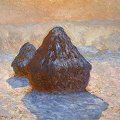 Get
Get  a high-quality picture of
Haystacks, White Frost Effect for your computer or notebook. ‣
With more than 20 canvases painted between the end of summer 1890 and the following winter, the stacks of wheat which were already present in his earlier works had grown to become truly imposing and, more importantly, the main motif of Monet's paintings. The series is composed of several sub-series which feature one or two stacks which are sometimes separate, sometimes close together, depending on the vantage point. The painter chose this theme principally because a piece of land near his house was used every year by an important farmer in Giverny as a storage area for his stacks. With the Haystacks, Monet's series became a deliberate choice rather than simply being what he observed: 'I am working hard, persisting with a series of different effects (on stacks), but the sun goes down so quickly at this time of year that I cannot keep up with it.' The stacks became his motif of choice for studying forms of light. The painter was 'looking for immediacy, especially in the 'envelope', the same light diffused everywhere'. For this he turned his attention to fleeting effects, variations created by the light at different times of day, as well as the season. The paintings reflect the position of the sun at the given moment through the lengthening of the shadows on the ground and the play of backlit effects. Fifteen or so Haystacks were presented at the exhibition 'Recent Works of Claude Monet' at the Durand-Ruel gallery in 1891.
a high-quality picture of
Haystacks, White Frost Effect for your computer or notebook. ‣
With more than 20 canvases painted between the end of summer 1890 and the following winter, the stacks of wheat which were already present in his earlier works had grown to become truly imposing and, more importantly, the main motif of Monet's paintings. The series is composed of several sub-series which feature one or two stacks which are sometimes separate, sometimes close together, depending on the vantage point. The painter chose this theme principally because a piece of land near his house was used every year by an important farmer in Giverny as a storage area for his stacks. With the Haystacks, Monet's series became a deliberate choice rather than simply being what he observed: 'I am working hard, persisting with a series of different effects (on stacks), but the sun goes down so quickly at this time of year that I cannot keep up with it.' The stacks became his motif of choice for studying forms of light. The painter was 'looking for immediacy, especially in the 'envelope', the same light diffused everywhere'. For this he turned his attention to fleeting effects, variations created by the light at different times of day, as well as the season. The paintings reflect the position of the sun at the given moment through the lengthening of the shadows on the ground and the play of backlit effects. Fifteen or so Haystacks were presented at the exhibition 'Recent Works of Claude Monet' at the Durand-Ruel gallery in 1891.
Houses of Parliament, Effect of Sunlight in the Fog (1901)
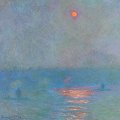 Get
Get  a high-quality picture of
Houses of Parliament, Effect of Sunlight in the Fog for your computer or notebook. ‣
From the balcony of his London hotel room overlooking the Thames, Monet could see Waterloo Bridge if he faced to his left. He worked on this subject through the afternoon and after dinner. Gustave Geffroy, a friend of Monet, described it in this way: 'Waterloo Bridge, made of huge solid stone, towered over the water like some aerial construction.' In this painting the morning mist partially conceals the industrial landscape of the opposite riverbank. So once again, the real subject becomes the atmospheric variations of the London environment. Hence the group of canvases around Waterloo Bridge have names reminiscent of the Grainstacks series painted by the artist a few years earlier.
a high-quality picture of
Houses of Parliament, Effect of Sunlight in the Fog for your computer or notebook. ‣
From the balcony of his London hotel room overlooking the Thames, Monet could see Waterloo Bridge if he faced to his left. He worked on this subject through the afternoon and after dinner. Gustave Geffroy, a friend of Monet, described it in this way: 'Waterloo Bridge, made of huge solid stone, towered over the water like some aerial construction.' In this painting the morning mist partially conceals the industrial landscape of the opposite riverbank. So once again, the real subject becomes the atmospheric variations of the London environment. Hence the group of canvases around Waterloo Bridge have names reminiscent of the Grainstacks series painted by the artist a few years earlier.
Houses of Parlilament, Fog Effect (1903)
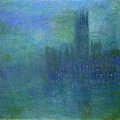 Get
Get  a high-quality picture of
Houses of Parlilament, Fog Effect for your computer or notebook. ‣
Monet returned to London for his second visit in 1900, this time by
himself, devoting his late afternoons to a single subject: the Houses of
Parliament. He worked on back-lit and sunset effects from a balcony of St.
Thomas' Hospital. While the first two series of canvases show the Central
Tower of the Parliament and its surrounding spires, this canvas from the
third series focuses on Victoria Tower. In these Parliament paintings,
Monet was searching for 'instantaneity', but he gives the subject an
unreal, ghostly appearance as it looms up like an apparition in the fog.
The stone architecture has lost all its substance and all that remains is a
silhouette, profiled against the sky, and its opaque reflection in the
Thames.
a high-quality picture of
Houses of Parlilament, Fog Effect for your computer or notebook. ‣
Monet returned to London for his second visit in 1900, this time by
himself, devoting his late afternoons to a single subject: the Houses of
Parliament. He worked on back-lit and sunset effects from a balcony of St.
Thomas' Hospital. While the first two series of canvases show the Central
Tower of the Parliament and its surrounding spires, this canvas from the
third series focuses on Victoria Tower. In these Parliament paintings,
Monet was searching for 'instantaneity', but he gives the subject an
unreal, ghostly appearance as it looms up like an apparition in the fog.
The stone architecture has lost all its substance and all that remains is a
silhouette, profiled against the sky, and its opaque reflection in the
Thames.
Water Lilies (1919)
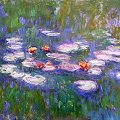 Get
Get  a high-quality picture of
Water Lilies for your computer or notebook. ‣
Because the space in front of his tiny pond was rather small, Monet wanted to acquire a larger area that would allow him to increase the variations in effects. So he bought a strip of meadow on the other side of the stream in 1901, and began work to divert the water so that he could enlarge his ornamental pond. He also wanted to plant in the pond water lilies that would cover the surface of the water reclaimed from the land. Soon, in 1903, he was able to produce a series of canvases with a water lily motif, which he continued the following year with another series using the same theme. The large, almost square canvases show the floating oval shapes of the large water lilies in a shifting perspective, suspended on a mirror of water. In this way the painter played with the effects of transparency and substance.
a high-quality picture of
Water Lilies for your computer or notebook. ‣
Because the space in front of his tiny pond was rather small, Monet wanted to acquire a larger area that would allow him to increase the variations in effects. So he bought a strip of meadow on the other side of the stream in 1901, and began work to divert the water so that he could enlarge his ornamental pond. He also wanted to plant in the pond water lilies that would cover the surface of the water reclaimed from the land. Soon, in 1903, he was able to produce a series of canvases with a water lily motif, which he continued the following year with another series using the same theme. The large, almost square canvases show the floating oval shapes of the large water lilies in a shifting perspective, suspended on a mirror of water. In this way the painter played with the effects of transparency and substance.
Water-Lilies and Weeping Willow Branches (1919)
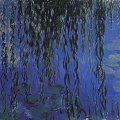 Get
Get  a high-quality picture of
Water-Lilies and Weeping Willow Branches for your computer or notebook. ‣
The water-lily pond at Giverny is overlooked by several weeping willows. The first one, to the southwest of the Japanese bridge, is depicted in a whole group of canvases - including this painting - executed in the middle of the First World War. Only the hanging branches of the two other willows on the north side of the pond appear in most of these pictures. The focus of interest then becomes the tree's curtain of foliage and the familiar subject of the water lilies. So Monet gives both the subject and his treatment of it a very decorative quality, signalling his determination to create a decorative ensemble. Many of the panels in the second room of the Orangerie have similar curtains.
a high-quality picture of
Water-Lilies and Weeping Willow Branches for your computer or notebook. ‣
The water-lily pond at Giverny is overlooked by several weeping willows. The first one, to the southwest of the Japanese bridge, is depicted in a whole group of canvases - including this painting - executed in the middle of the First World War. Only the hanging branches of the two other willows on the north side of the pond appear in most of these pictures. The focus of interest then becomes the tree's curtain of foliage and the familiar subject of the water lilies. So Monet gives both the subject and his treatment of it a very decorative quality, signalling his determination to create a decorative ensemble. Many of the panels in the second room of the Orangerie have similar curtains.
Claude Monet Art

|
|
More
Articles
 Art Encyclopedia A world history of art in articles.
Art Encyclopedia A world history of art in articles.
Impressionism
Claude Monet
Life and work.
Starting the Impressionism.
Colors in Claude Monet's paintings.
Best paintings.
Art
 Art Wallpapers Art image collections for your desktop.
Art Wallpapers Art image collections for your desktop.
Monet Art, $35
(250 pictures)
Degas Art, $25
(170 pictures)
Renoir Art, $39
(300 pictures)
